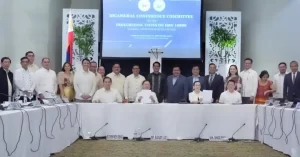Ever heard the term ” bicam reports ” and wondered what it was all about? 🤔
This seemingly complex document plays a crucial role in the Philippine legislative process. 🇵🇭
This guide will break down everything you need to know about bicameral conference committee reports, also known as “bicam” reports, in simple terms. We’ll explain what they are, why they’re important, and how they help shape the laws of the land. Plus, we’ll provide frequently asked questions and answers.
Let’s get started! 👇

Advertisement:

⚖️ Bicameral Conference Committee Reports: Your Guide to Understanding Bicam Reports in the Philippines
Table of Contents
What is a Bicameral Conference Committee Report?
In the Philippines, laws are made by Congress, which is composed of two houses: the Senate and the House of Representatives. Sometimes, the Senate and the House pass different versions of the same bill. That’s where the Bicameral Conference Committee comes in.
Here’s the lowdown:
- Bicameral: Means “two chambers” – referring to the Senate and the House of Representatives.
- Conference Committee: A special committee made up of members from both the Senate and the House.
- Purpose: To reconcile or resolve the differences between the Senate and House versions of a particular bill. They hammer out a compromise version that both chambers can agree on.
- Report: The committee’s output is a Bicameral Conference Committee Report, or simply, a “bicam report.” This document contains the unified and final version of the bill.
Think of it like this: Imagine two chefs (the Senate and the House) cooking the same dish (a bill) but using slightly different recipes. The Bicameral Conference Committee is like a team of expert tasters who combine the best parts of each recipe to create a single, delicious dish that everyone can enjoy.
Why are Bicam Reports Important?
Bicam Reports are essential because:
- They ensure that both houses of Congress agree on a single version of a bill before it can become law. This prevents conflicting provisions and ensures a unified legislative intent.
- They represent a compromise between the two chambers. This reflects the different perspectives and interests represented in the Senate and the House.
- They are the final step in the legislative process before a bill is sent to the President for approval. Without a reconciled version from the bicam, a bill cannot become law.
- The Signed Bicam Report is the Basis for the Enrolled Bill: This is crucial. The enrolled bill, which is the final, official copy of the bill sent to the President, is prepared based on the signed bicam report. Signatures from both chambers on the report are required to confirm their agreement and the authenticity of the final version.
The Philippine Legislative Process: A Simplified View
Here’s a simplified overview of how a bill becomes a law in the Philippines, highlighting the role of the bicam report:
| Step | Description |
|---|---|
| 1. Bill Filing | A bill is filed in either the House of Representatives (House Bill) or the Senate (Senate Bill). |
| 2. First Reading | The bill’s title and number are read on the floor, and it is referred to the appropriate committee. |
| 3. Committee Hearings | The committee conducts hearings, studies the bill, and may amend it. |
| 4. Second Reading | The bill is debated on the floor, and further amendments may be proposed. |
| 5. Third Reading | The final version of the bill is voted on. |
| 6. Transmission to the Other Chamber | If approved, the bill is sent to the other chamber (Senate to House or House to Senate) where it goes through the same process (Steps 2-5). |
| 7. Bicameral Conference Committee | If the two chambers pass different versions of the bill, a Bicameral Conference Committee is formed to reconcile the differences. The committee then produces a bicam report, which contains the unified version of the bill. |
| 8. Approval of Bicam Report | Both the Senate and the House must approve the bicam report, signified by the signatures of a majority of the committee members from each chamber. |
| 9. Enrolled Bill | Once the bicam report is signed and approved, the final version of the bill, known as the enrolled bill, is prepared based on the report. |
| 10. Presidential Action | The President can either sign the enrolled bill into law or veto it. |
Anatomy of a Bicam Report: What Does it Contain?
A typical bicam report includes the following sections:
- Heading:
- Name of the Committee: “Conference Committee on the disagreeing provisions of [House Bill No.] and [Senate Bill No.]”
- Bill Number and Title: The numbers and titles of the reconciled bills.
- Date: The date the report was finalized.
- Attendance:
- Lists the members of the committee from both the Senate and the House of Representatives who were present. Usually, there is a chairperson from each house.
- Recommendations:
- This section outlines the changes and compromises agreed upon by the committee. It details how the differences between the Senate and House versions were resolved.
- Explanation of Changes:
- Provides a justification for the amendments made to the bill. This section explains the rationale behind the committee’s decisions.
- Signatures:
- The report must be signed by a majority of the committee members from each chamber. This signifies their agreement on the reconciled version and is crucial for the report’s validity. The signed report then becomes the basis for the enrolled bill that is sent to the President.
Frequently Asked Questions (FAQs)
What does “bicam” mean?
“Bicam” is short for “bicameral,” which refers to a legislature with two chambers or houses. In the Philippines, it refers to the Senate and the House of Representatives.
Who are the members of a bicameral conference committee?
The committee is composed of members from both the Senate and the House of Representatives, usually from the committees that originally handled the bill.
How long does a bicameral conference committee have to reconcile a bill?
There is no strict time limit, but committees typically aim to complete their work as quickly as possible, especially for urgent bills.
What happens if the bicameral conference committee cannot agree on a compromise version?
If the committee fails to reach an agreement, the bill may be considered dead, or further negotiations may be attempted.
Where can I find actual bicam reports?
Bicam reports are usually made public and can be found on the official websites of the Senate and the House of Representatives.
Why is the bicameral conference committee sometimes called the “third chamber” of Congress?
It’s called the “third chamber” because it has significant power in shaping the final version of a bill, sometimes even introducing new provisions that weren’t in the original House or Senate versions. This has led to some criticism and debate about the committee’s power.
What is the role of the President in the legislative process after the bicam report is approved?
After both chambers approve the signed bicam report, the final version of the bill, called the “enrolled bill,” is prepared based on the signed report and sent to the President. The President can then either sign the bill into law or veto it.
How does a bill become a law in the Philippines?
A bill must pass through several stages, including readings and debates in both the House and Senate, reconciliation by a bicameral conference committee (if necessary), and finally, approval by the President.
Why is it important for the bicam report to be signed by both chambers?
The signatures from a majority of members of each chamber’s panel signify their agreement on the final version of the bill. Without these signatures, the bicam report is not considered valid, and the enrolled bill cannot be prepared and sent to the President for approval. The signed report ensures that the final version of the bill accurately reflects the compromises made by both the Senate and the House.
Pinoy Trending Disclaimer
Pinoy Trending informs that this article is intended for informational purposes only and aims to explain the concept of bicameral conference committee reports in the Philippine legislative process. It is not intended as legal advice.
Pinoy Trending is not affiliated with the Philippine government or any political party. The information provided here is based on publicly available data and may not be completely up-to-date. Please refer to official sources for the most accurate and current information.
References
- Official Website of the Senate of the Philippines: www.senate.gov.ph
- Official Website of the House of Representatives: www.congress.gov.ph
- The 1987 Constitution of the Republic of the Philippines
- “Philippine Government and Constitution” by Hector S. De Leon and Hector M. De Leon Jr.
- “The Legislative Process: A Handbook for Public Officials and Citizens” by the Senate Legislative Research Service.
- Gemini
- ChatGPT
Josh is a seasoned content writer and journalist with over 15 years of experience creating impactful, accurate, and engaging content across industries like technology, healthcare, finance, and media. He specializes in translating complex topics into clear, accessible narratives and excels in technical documentation, editorial writing, and marketing materials.
A skilled journalist, Josh delivers in-depth features and articles that resonate with readers. Known for his attention to detail, research skills, and reliability, he is dedicated to producing high-quality content that informs, educates, and inspires.


